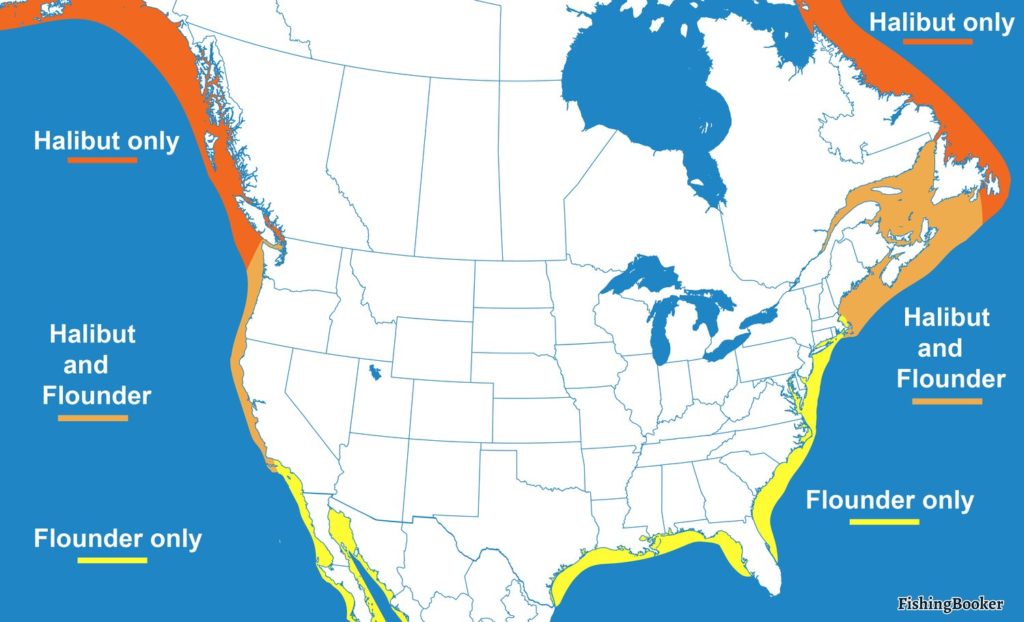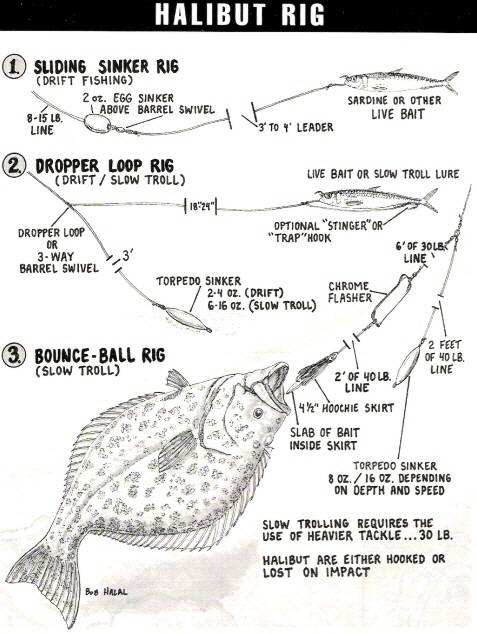The Pacific Halibut, a leviathan of the ocean floor, ignites a fire in the hearts of anglers across the US. Their immense size, dogged fighting spirit, and prized flesh make them a holy grail for both recreational and commercial fishermen. This in-depth guide equips you with the knowledge and techniques to target these underwater giants, from the icy waters of Alaska to the nutrient-rich kelp forests of California.
Decoding the Halibut: A Life on the Bottom
Understanding halibut behavior is the cornerstone of successful fishing. Here’s a breakdown of key factors to consider:
Habitat Preferences:
- Demersal Dwellers: Halibut are flatfish that prefer the comfort of the ocean floor. They favor sandy or gravelly bottoms where they can easily camouflage themselves and ambush unsuspecting prey.
- Depth Domain: Halibut’s depth range is vast, from shallow coastal areas teeming with life to frigid depths exceeding 1,200 feet. Typically, they are targeted between 50 and 400 feet deep.
- Temperature Kings: These cold-blooded giants thrive in cooler waters, with a preference for temperatures ranging from 37°F to 46°F. This is why the northern Pacific Ocean, particularly Alaska and the Pacific Northwest, is a halibut haven.

Feeding Habits:
- Masters of Opportunity: Halibut are not picky eaters. They are opportunistic feeders, preying on a diverse menu that includes fish like herring, cod, and sand lance, along with invertebrates such as octopus, crabs, and squid.
- Tidal Treats: Halibut tend to be more active feeders during tidal changes, particularly the incoming tide. Early morning and late evening can also be prime feeding times as these periods offer low-light conditions that halibut favor for hunting.
Equipping Yourself for the Battle: The Right Tools for Halibut Triumph
Choosing the right equipment is essential to wrestling a halibut to the surface:
Rods:
- Heavy Hitters: A heavy-powered rod with a fast action is your trusted companion. This combination provides the backbone to handle powerful runs and the sensitivity to detect subtle taps from halibut investigating your bait.
- Length Matters: A rod length of 6 to 7 feet offers a good balance of leverage for fighting large fish and control for jigging and bait presentations. Shorter rods can be suitable for smaller boats with limited space.
Reels:
- Conventional Choice: Conventional reels are the workhorses of halibut fishing, prized for their power and durability. Choose a reel with a high line capacity (800+ yards) to handle long runs and a strong drag system to subdue these powerful fish.
- Electric Option: For depths exceeding 300 feet, electric reels can be a game-changer. They help you retrieve heavy weights and battle trophy halibut with less fatigue.
Lines:
- Braided Strength: Braided line in the 50-100 lb test range is a popular choice due to its high strength, minimal stretch for better hook sets, and superior sensitivity for feeling even the slightest nibbles.
- Monofilament Leader: A monofilament leader in the 80-200 lb test range is crucial. Monofilament offers some stretch to absorb a halibut’s initial strike and reduces the chance of hook pulls, while also providing abrasion resistance against rocks and kelp. Leader length can vary from a few feet to the length of your bait rig.
Rigs and Baits:
- Circle Hooks for Safety: Circle hooks are strongly recommended for halibut fishing. They hook the fish in the jaw corner, increasing the chances of a secure catch and release or easier removal if you plan to keep the fish.
- Jigs with Appeal: Large, heavy jigs (8-16 ounces) are effective for attracting halibut in deep water. Choose jigs with glow-in-the-dark features or bright colors to provide attraction in low-light conditions. Consider adding soft plastic trailers for extra enticement.
- Bait Rigs for Authenticity: Bait rigs, such as the spreader bar rig, are highly effective when using live or cut bait like herring, squid, octopus, or large chunks of fish. These rigs present the bait in a natural swimming motion, mimicking wounded prey.

Mastering the Art of Presentation: Techniques to Fool the Halibut
Presentation is key to enticing bites from these wary bottom dwellers. Here are some effective techniques to consider:
Anchoring vs. Drifting:
- Anchored Ambush: Anchoring your boat over promising halibut grounds allows you to fish vertically and keep your bait in the strike zone for extended periods. Use a fish finder to locate areas with structure (underwater rocks, reefs, wrecks) or signs of baitfish activity.
- Drifting Dynamics: Drifting is a dynamic approach that allows you to cover more ground and can be effective in locating scattered halibut. Drift with the current or wind, using enough weight to keep your bait bouncing along the bottom. This technique is particularly useful in areas with consistent depths and minimal snags.
- Bait Presentation:
- Bottom Bouncing: The most common presentation involves keeping your bait or jig in constant contact with the bottom. Use enough weight to maintain bottom contact, but not so much that you snag constantly. Raise the rod tip slightly every few seconds to create a hopping motion that can trigger halibut strikes.
- Deadsticking Deception: Deadsticking involves letting your bait sit motionless on the bottom for extended periods. This technique can be surprisingly effective for lethargic halibut, especially during colder months or when using live bait.
- Slow Jigging Symphony: Slow, rhythmic jigging motions can entice halibut to strike. Lift the jig a foot or two off the bottom and then slowly let it flutter back down, mimicking a wounded baitfish. Experiment with different jigging cadences to see what triggers bites.
- Seasonal Considerations:
- Spring and Summer: These are prime seasons for halibut fishing in shallower waters (50-150 feet) as they stage for spawning and actively feed. Target areas with strong tidal flow near rocky structures or kelp beds where baitfish congregate.
- Fall and Winter: Halibut can still be caught during these colder months, but they tend to move into deeper waters (150-400+ feet). Heavier weights, electric reels, and glow-in-the-dark jigs become more important for deeper presentations. Focus on areas with underwater slopes or canyons where halibut might be resting or following baitfish.

Additional Tips for Halibut Fishing Mastery
Scent and Attractants:
- Adding Olfactory Appeal: Halibut have a strong sense of smell. Adding scent attractants like fish oil, shrimp paste, or commercially available baits with infused scents can significantly increase your chances of attracting halibut, especially in areas with poor water clarity.
- Flash and Vibration: Jigs and lures with reflective surfaces, rattles, or glow sticks can be highly effective in low-light conditions or deeper water. The flash and vibration can attract halibut from afar and trigger their predatory instincts.
Patience and Persistence:
- Waiting for the Bite: Halibut fishing can require patience. Be prepared to wait for bites, especially when using deadsticking tactics. Don’t get discouraged by slow periods; keep experimenting with different techniques and locations throughout the day.
- Repositioning for Success: If you haven’t received any bites after a considerable amount of time in one spot, don’t hesitate to reposition your boat. Utilize your fish finder to search for promising areas with structure changes or baitfish schools.
Safety First:
- Be Prepared for the Sea: Halibut fishing often takes place in remote offshore waters. Ensure your boat is equipped with all necessary safety gear, including life jackets, a first-aid kit, emergency signaling devices, a VHF radio, and a GPS unit.
- Check Regulations: Always check local fishing regulations for size and bag limits, as well as any seasonal restrictions in place to ensure sustainable fishing practices.
- Respect the Power: Halibut are powerful fish. Handle them with care to avoid injury. Use a gaff or net to land large halibut, and consider using padded gloves for extra protection.

Robert Smith is the proud owner of Bait Barrels and Bows, a premier fishing sports store established in 1989. With over three decades of experience in the industry, Robert has honed his skills to become an expert angler, sharing his vast knowledge and passion for fishing with enthusiasts around the world. Through his store and writings, Robert provides invaluable tips and guidance, helping both novice and seasoned anglers improve their techniques and enjoy the sport to its fullest. His commitment to the fishing community is evident in his dedication to quality products and excellent customer service.

